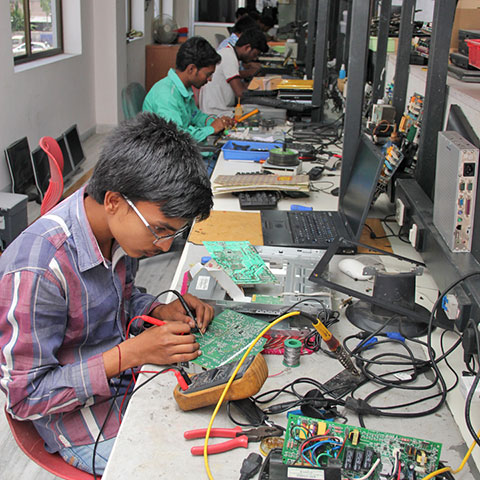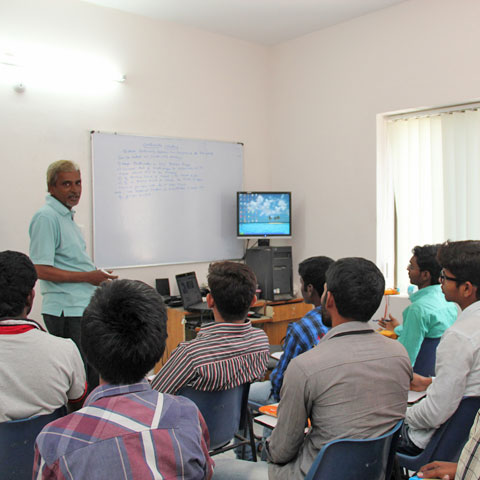We offer best training that will create a thorough practical knowledge which will enhance your skills and improve your employability prospects.
Here are the courses we offer...
Click on each title to see details
Duration: 60 Days
► Basic Electronics ► Power Units (SMPS) ► Desktop Mother Board ► Laptop A to Z
Basic Electronics
Explanation of Characteristics, Function, Physical Appearance, Circuit Symbol and Testing with Multi meter of below components.
AC, DC Current • Conductors • Insulators • Semiconductors • Resistors • Capacitors • Diodes • IC’s • Amplifiers • Transistors (BJTs, MOSFETs) • Oscillators Concept • Electro Static Induction • Electro Magnetic Induction • Coils/Transformers
Power Units (SMPS)
SMPS block Diagram • Working principle • All O/P voltages • Circuit board tracing • Identifying different sections & components • Trouble shooting
Desktop Mother Board
Identifying different sections & components on Motherboard • Motherboard BLOCK Diagram • Power Sequence • Voltage to memory module • VRM section diagram • Core Voltage to CPU • Supply to clock generator & clock pulse distribution • Supply to Audio and LAN chips • Bios function • Chip Set Explanation • Key voltage points • Step by Step Troubleshooting guide'
Laptop A to Z
De-assembling and assembling of laptop • Replacing screen & Hinges • Checking Battery • Adaptor Ratings, voltage checking, working, Trouble shooting • Laptop Block Diagram • Identifying Different sections • Identifying Different components • Data sheet Reading • Circuit Diagram Reading • Power on sequence • Volt in Section • SIO Section • Battery Charging Section • Trouble shooting dead laptop • BGA Chip Re-floating • Trouble shooting battery not charging problem • Voltage to clock, Bios, audio, LAN chips • Voltage to Memory Section, Types of Rams and their voltages • Fixing Restarting problem • Trouble shooting powers OK no Display issue • Fixing Over Heating Problem • Inverter section troubleshooting • Drive not detecting • USB port not detecting • Keyboard not detecting • CAM not working • BIOS Programming • Usage of function keys • Partition & formatting the Hard drive • Installation Configuring of Peripherals and all device drivers
Duration: 15 Days
Basics of Electricity and Electronics
Current • Voltage • Resistance • Power • Energy • Ohm’s Law • Series and Parallel circuit • AC and DC current • Semi conductor’s • Diodes • Transistors • Capacitors • Coils • Transformers
Solar Power
Introduction to Solar Energy • Basic of solar photo-voltaic power systems For residential and commercial use • BLOCK Diagram • Components in Solar system • Solar panel and its parameters • How PV cell works • Battery Voltage & Current ratings • Load and Back-up time calculations • Connecting Batteries in Series and Parallel • Battery charging controller circuit (Explanation & Trouble shoot) • Types of Inverters • Inverter circuit explanation • Installation and Troubleshooting • Estimation and project report
Duration: 15 Days
CCTV System Introduction, BLOCK diagram • Analog and Digital Technologies • Concept of current, voltage, power • Types of cameras (Dome, Bullet, P-T-Z • Types of camera technologies (Analog, AHD,IP) • Explanation of Lens, sensor, DSP • DVR and NVR concepts • Types of cables and connectors used in CCTV system • Video Recording (Scheduling and planning) • CCTV footage view • Video backup • Audio record • 264 Compression technology • CCTV footage live local view through PC • Router configuration • Port forwarding • CCTV footage Remote View through PC and mobile
Module 1: Information Security Governance
- Establish and maintain an information security strategy, and align the strategy with corporate governance
- Establish and maintain an information security governance framework
- Establish and maintain information security policies
- Develop a business case
- Identify internal and external influences to the organization
- Obtain management commitment
- Define roles and responsibilities
- Establish, monitor, evaluate, and report metrics
Module 2: Information Risk Management and Compliance
- Establish a process for information asset classification and ownership
- Identify legal, regulatory, organizational, and other applicable requirements
- Ensure that risk assessments, vulnerability assessments, and threat analyses are conducted periodically
- Determine appropriate risk treatment options
- Evaluate information security controls
- Identify the gap between current and desired risk levels
- Integrate information risk management into business and IT processes
- Monitor existing risk
- Report noncompliance and other changes in information risk
Module 3: Information Security Program Development and Management
- Establish and maintain the information security program
- Ensure alignment between the information security program and other business functions
- Identify, acquire, manage, and define requirements for internal and external resources
- Establish and maintain information security architectures
- Establish, communicate, and maintain organizational information security standards, procedures, and guidelines
- Establish and maintain a program for information security awareness and training
- Integrate information security requirements into organizational processes
- Integrate information security requirements into contracts and activities of third parties
- Establish, monitor, and periodically report program management and operational metrics
Module 4: Information Security Incident Management
- Establish and maintain an organizational definition of, and severity hierarchy for, information security incidents
- Establish and maintain an incident response plan
- Develop and implement processes to ensure the timely identification of information security incidents
- Establish and maintain processes to investigate and document information security incidents
- Establish and maintain incident escalation and notification processes
- Organize, train, and equip teams to effectively respond to information security incidents
- Test and review the incident response plan periodically
- Establish and maintain communication plans and processes
- Conduct post-incident reviews
- Establish and maintain integration among the incident response plan, disaster recovery plan, and business continuity plan
Module 1: Cybersecurity Introduction and Overview
- Topic 1: Introduction to Cybersecurity
- Definition and Importance
- Historical Context
- Topic 2: Difference between Information Security and Cybersecurity
- Key Differences
- Overlaps and Interconnections
- Topic 3: Cybersecurity Objectives
- Confidentiality, Integrity, Availability (CIA Triad)
- Other Key Objectives
- Topic 4: Cybersecurity Roles
- Key Roles and Responsibilities
- Career Pathways
- Topic 5: Cybersecurity Domains
- Overview of Domains
- Importance of Each Domain
Module 2: Cybersecurity Concepts
- Topic 1: Risk
- Understanding Risk in Cybersecurity
- Risk Assessment Methodologies
- Topic 2: Common Attack Types and Vectors
- Overview of Attack Types (e.g., Phishing, Malware)
- Common Vectors (e.g., Email, Networks)
- Topic 3: Policies and Procedures
- Importance of Documentation
- Key Policies to Implement
- Topic 4: Cybersecurity Controls
- Types of Controls (Preventive, Detective, Corrective)
- Examples and Best Practices
Module 3: Security Architecture Principles
- Topic 1: Overview of Security Architecture
- Definition and Importance
- Topic 2: The OSI Model
- Layers of the OSI Model
- Security Considerations at Each Layer
- Topic 3: Defense in Depth
- Concept and Strategy
- Layered Security Approaches
- Topic 4: Firewalls
- Types of Firewalls
- Configuration Best Practices
- Topic 5: Isolation and Segmentation
- Network Segmentation Strategies
- Benefits and Implementation
- Topic 6: Monitoring, Detection and Logging
- Importance of Monitoring
- Tools and Techniques
- Topic 7A: Encryption Fundamentals
- Basics of Encryption
- Key Concepts
- Topic 7B: Encryption Techniques
- Symmetric vs. Asymmetric Encryption
- Common Algorithms
- Topic 7C: Encryption Applications
- Use Cases in Cybersecurity
- Best Practices for Implementation
Module 4: Security Networks, Systems, Applications, and Data
- Topic 1: Process Controls - Risk Assessments
- Conducting Risk Assessments
- Tools and Techniques
- Topic 2: Process Controls - Vulnerability Management
- Identifying and Managing Vulnerabilities
- Topic 3: Process Controls - Penetration Testing
- Overview of Penetration Testing
- Methodologies and Tools
- Topic 4: Network Security
- Key Concepts and Best Practices
- Topic 5: Operating System Security
- Securing Operating Systems
- Common Vulnerabilities
- Topic 6: Application Security
- Secure Development Practices
- Application Testing Techniques
- Topic 7: Data Security
- Data Protection Strategies
- Compliance and Regulations
Module 5: Incident Response
- Topic 1: Event vs. Incident
- Definitions and Differences
- Topic 2: Security Incident Response
- Incident Response Planning
- Steps in the Incident Response Process
- Topic 3: Investigations, Legal Holds, and Preservation
- Importance of Forensic Investigations
- Legal Considerations
- Topic 4: Forensics
- Overview of Digital Forensics
- Tools and Techniques
- Topic 5: Disaster Recovery and Business Continuity Plans
- Developing Effective Plans
- Testing and Maintenance
Module 6: Security Implications and Adoption of Evolving Technology
- Topic 1: Current Threat Landscape
- Overview of Current Threats
- Trends and Predictions
- Topic 2: Advanced Persistent Threats
- Definition and Characteristics
- Mitigation Strategies
- Topic 3: Mobile Technology - Vulnerabilities, Threats, and Risk
- Understanding Mobile Threats
- Security Best Practices
- Topic 4: Consumerization of IT and Mobile Devices
- Implications for Security
- Strategies for Management
- Topic 5: Cloud and Digital Collaboration
- Security in Cloud Environments
- Best Practices for Collaboration Tool
- Network Fundamentals
- What is Network
- Essential components of Networks
- Communication Modes
- OSI Reference Model
- TCP/IP model
- Logical ports and protocols.
- TCP and UDP differences
- Transport layer communication basics
- Network Types, LAN, MAN, WAN
- Guided and Un guided Media
- Network interface card types
- NIC, function and Application.
- Physical Media and interfaces.
- Introduction to Network devices.
- Layer 2 and Layer 3 Devices.
- Basic CLI tools for Network diagnostics.
- IP Address, Classes and use cases.
- Network Topologies
- Overview on different media, types, limitations
- Detailed discussion on IPV4 and intro to IPV6.
- Wireless communication,
- SSID.
- WIFI channels. MAC address tables Switching types.
- MAC address learning.
- VLAN and advantages. 2.0 NETWORK ACCESS
- Inter VLAN communication • Spanning tree
- Trunks ports.
- Native VLANS.
- Inter switch connections and communication.
- Verify Layer 2 connectivity and troubleshoot.
- Ether channel
- Spanning tree protocols 3. IP CONNECTIVITY
- Routing • Layer 3 communication basics, and devices.
- Prefix, Gateways
- Metrics. • Administrative distance.
- Criteria for routing decisions • Static Routing
- Default Routing • Floating static routing.
- Distance vector and Link state Routing protocols
- RIP • OSPF • NAT advantages. 4. IP SERVICES.
- NAT operation and use cases. • DHCP and operation
- Troubleshooting DHCP issues.
- Secure communication access.
- 5.0 SECURITY FUNDAMENTS
- Virus, worms, Trojans.
- Vulnerabilities, Threats, Risk.
- Access controls and types.
- Policies, procedures, standard and baselines.
- Wireless security protocols
- Access control lists and Network security.
- Domain 1 Security and Risk Management 16%
- Understand, adhere to, and promote professional ethics
- Understand and apply security concepts
- Evaluate, apply, and sustain security governance principles
- Understand legal, regulatory, and compliance issues that pertain to information security in a holistic context
- Understand requirements for investigation types (i.e., administrative, criminal, civil, regulatory, industry standards)
- Develop, document, and implement security policy, standards, procedures, and guidelines
- Identify, analyze, assess, prioritize, and implement Business Continuity (BC) requirements
- Contribute to and enforce personnel security policies and procedures
- Understand and apply risk management concepts
- Understand and apply threat modeling concepts and methodologies
- Apply supply chain risk management (SCRM) concepts
- Establish and maintain a security awareness, education, and training program
- Domain 2 Asset Security
- Identify and classify information and assets
- Establish information and asset handling requirements
- Provision information and assets securely
- Manage data lifecycle
- Ensure appropriate asset retention (e.g., End of Life (EOL), End of Support)
- Determine data security controls and compliance requirements
- Domain 3 Security Architecture and Engineering
- Research, implement, and manage engineering processes using secure design principles
- Understand the fundamental concepts of security models (e.g., Biba, Star Model, Bell-LaPadula)
- Select controls based upon systems security requirements
- Understand security capabilities of Information Systems (e.g., memory protection, Trusted Platform Module (TPM), encryption/decryption)
- Assess and mitigate the vulnerabilities of security architectures, designs, and solution element
- Select and determine cryptographic solutions
- Understand methods of cryptanalytic attacks
- Apply security principles to site and facility design
- Design site and facility security controls
- Manage the information system lifecycle
- Domain 4 Communication and Network Security 13%
- Apply secure design principles in network architectures
- Secure network components
- Implement secure communication channels according to design
- Domain 5 Identity and Access Management (IAM)
- Control physical and logical access to assets
- Design identification and authentication strategy (e.g., people, devices, and services)
- Federated identity with a third-party service
- Implement and manage authorization mechanisms
- Manage the identity and access provisioning lifecycle
- Implement authentication systems
- Domain 6 Security Assessment and Testing
- Design and validate assessment, test, and audit strategies
- Conduct security controls testing
- Collect security process data (e.g., technical, and administrative)
- Analyze test output and generate report
- Conduct or facilitate security audits
- Domain 7 Security Operations
- Understand and comply with investigations
- Conduct logging and monitoring activities
- Perform configuration management (CM) (e.g., provisioning, baselining, automation)
- Apply foundational security operations concepts
- Apply resource protection
- Conduct incident management
- Operate and maintain detection and preventative measures
- Implement and support patch and vulnerability management
- Understand and participate in change management processes
- Implement recovery strategies
- Implement disaster recovery (DR) processes
- Test disaster recovery plan (DRP)
- Participate in Business Continuity (BC) planning and exercises
- Implement and manage physical security
- Address personnel safety and security concerns
- Domain 8 Software Development Security
- Understand and integrate security in the Software Development Life Cycle (SDLC)
- Identify and apply security controls in software development ecosystems
- Assess the effectiveness of software security
- Assess security impact of acquired software


